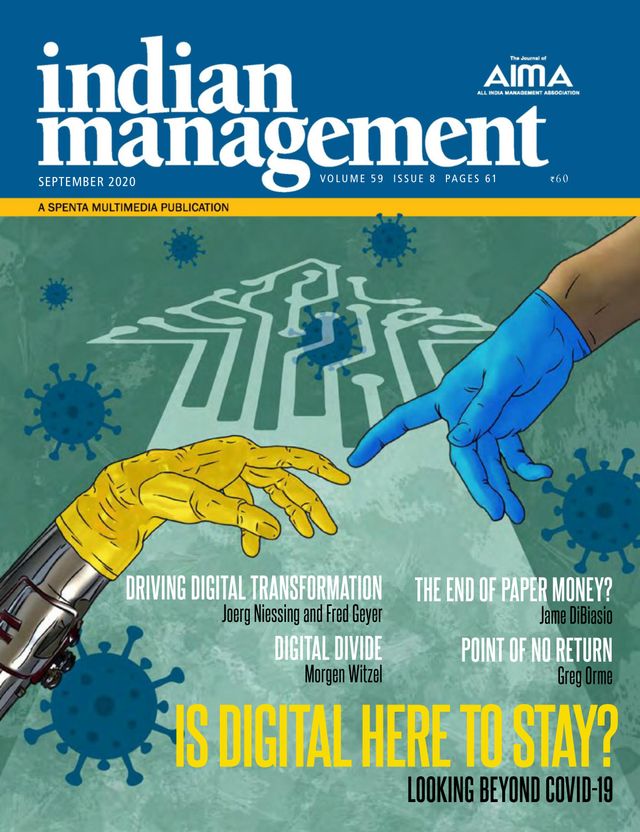The Point of No Return
Home // The Point of No Return
- Greg Orme
Why Covid-19 is forcing business leaders to accelerate digital innovation
There’s a joke circulating on social media. It’s a fake questionnaire that asks: ‘Who’s driving your digital transformation?’
Option A: CEO
Option B: CTO
Option C: COVID-19
At the beginning of the pandemic, many organisations went into survival mode. Leaders reported they were frantically shoring up the core revenue streams, conserving cash and minimising risk. They were waiting for ‘more clarity’ before innovating their business model. We’ve entered a new stage in this unfolding crisis. We’re now clear on one thing: clarity is many months, perhaps years, away.
When pilots are mapping out a flight they always note an important spot on their intended journey. It’s when the aircraft hasn’t sufficient fuel to return to the airfield from which it took off. They call it ‘the point of no return’. Some business managers are still asking: ‘How long before our commercial world gets back to normal?’ I’d argue the question has become redundant and risky. A better question is: ‘How can we need to innovate to ensure we serve our customers in a changed world?’.
The power of technological innovation is plain to observe in the war against the virus. We’re seeing everything from 3-D printed ‘hands-free’ door openers, ventilators powered by car windscreen-wiper motors and smart face masks with tiny sensors to detect Covid symptoms and fatigue. These innovations are reminiscent of those that sprung from the Second World War which sparked the invention of the digital computer, rocket technology, jet engines, pressurised plane cabins, radar – and even super glue and ballpoint pens. If necessity is the mother of invention, technology is often the father.
This pioneering spirit is now rippling through the business world. Even before the crisis, 92 percent of companies believed their business models would need to change to become more digitised. New research shows businesses, consumers and employees have vaulted five years forward in digital adoption in just a matter of months. Hundreds of millions of people have tasted home working for the first time. Polls indicate many would like to keep working remotely for at least a few days each week. The use of digital collaboration platforms like Zoom and Microsoft Teams will continue to grow. Covid-19 has undoubtedly catalysed rapid adoption of technology. Smart business leaders will now pick up that baton and run with it.
Leaders need to focus on how to solve the problems of our ‘new normal’ using digital technology. In the recession after the 2008 financial crash research illustrated the businesses that thought ‘through’ the crisis to the other side, and planned for the what came next, outstripped their rivals for many years. Likewise, proactivity will pay off now.
Here are three focus areas to leverage technological innovation in the post-Covid world.
1. Think like a start-up
In a crisis you can’t just plan towards the future, you must re-imagine it. Not surprising then, that poll after poll of CEOs show creativity rising up the hierarchy of valuable skills. Right now, the first step to developing a more entrepreneurial mindset is to accept customer behaviours and attitudes have shifted significantly. The second step, ask the question: ‘What are the new pain points in our customer’s life?’
In the past ‘going digital’ has been interpreted by some as ‘taking our current paper-based forms and putting them online’ – just ask my high street bank in the UK. During the pandemic, customers have undergone a Covid-sponsored digital crash course. Naturally, they’re now demanding at-home and ‘low-touch’ options in both B2C and B2B.
You may have been the world’s greatest expert on your customer but the world has changed. You need to go back to school on their needs. Like a start-up with a brand new product, this entails meticulously re-discovering your customer’s journey. Working out where this journey is painful, and offering tech-enabled solutions. Technology is not an end in itself. It’s simply a powerful way to solve problems, which is always at the heart of innovation.
During the pandemic, customers have undergone a Covid-sponsored digital crash course. Naturally, they’re now demanding at-home and ‘low-touch’ options in both B2C and B2B. You may have been the world’s greatest expert on your customer but the world has changed. You need to go back to school on their needs.
Greg Orme, author of The Human Edge Click to Tweet
2. Build teams with greater agility
Tech-enabled businesses have already shown how fast they can move. For example, the India food business Zomato recently used its digital platform to work with grocery start-ups to meet surging online demand However, being entrepreneurial is more than just being fast. Speed means moving in one direction as fast as possible. A disrupted environment requires you to change direction too. That’s agility.
Over the last few decades, I’ve witnessed global clients – from financial services to automotive, hospitality to consulting – striving to emulate the speed, dynamism, and customer-centricity of digital players. Many have trialled Agile working (a cross-functional team structure) as well as Design Thinking (a method for uncovering problems that need solving, then brainstorming better solutions). I predict Covid-19 will further accelerate these attitudinal and structural changes inside forward-looking organisations.
3. Experiment at scale
Agile and Design Thinking align with a technique I’ve been helping to imbed into global organisations through my work at London Business School: experimentation. The objective of a business experiment is to question the world, then create a relatively risk-free route to test your assumptions. Experiments are small scale and action-based. They side-step the corporate tendency for prolonged and intense study of ‘the obvious’.
Experiments also make failure survivable. They rapidly establish what works, and what doesn’t using the smallest possible amount of time, money and effort. It’s a philosophy summed up by the slogan: ‘Think Big, Start Small, Learn Fast’. Jeff Bezos often cites experimentation as his secret weapon: ‘Our success at Amazon is a function of how many experiments we do per year, per month, per week, per day.’ We’ve seeing trial-and-error experimentation at scale across industries during the crisis. For example, fitness companies are offering extended free trials for online and app-based classes. In my world – executive education – we’ve had to switch to 100% (up from around 10%) online delivery almost overnight. This has required us to perform hundreds of experiments to find the best ways to engage leaders at a distance.
It’s dangerous for a pilot to yearn for the alluring safety of their ‘home’ airport after passing the point of no return. At this moment, playing it safe becomes more not less dangerous. For many business leaders that’s the reality now. Like it or not, they’ve embarked on a journey to somewhere new. Understanding how to use digital technology will help them to land safely in the post-Covid world.
This blog is adapted from an article written for the business magazine Indian Management.
The insights are adapted from my latest book The Human Edge: How curiosity and creativity are your superpowers in the digital economy (Pearson) which won the Business Book of The Year 2020.
All right reserved Copyright © 2020 Greg Orme

Related posts

Does Your Busy Culture Undermine Mental Health?
4 min read – As we move into the post-pandemic era, the ability to feel or imagine another person’s emotional experience will become even more important.

For Happiness In Tough Times, Be More Grateful
4 min read – As we move into the post-pandemic era, the ability to feel or imagine another person’s emotional experience will become even more important.

Caring Got Cool: Diverse, Remote Teams Make Empathy A Vital Skill For Managers
4 min read – As we move into the post-pandemic era, the ability to feel or imagine another person’s emotional experience will become even more important.